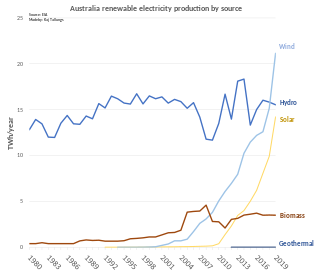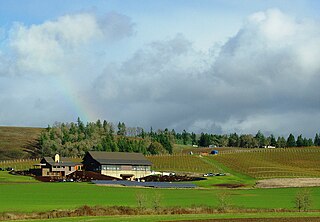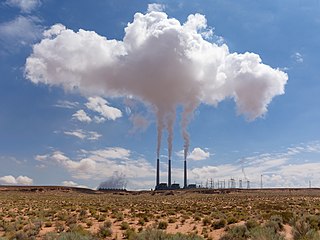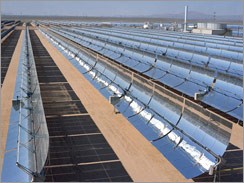Related Research Articles

Energy conservation is the effort to reduce wasteful energy consumption by using fewer energy services. This can be done by using energy more effectively or changing one's behavior to use less service. Energy conservation can be achieved through efficient energy use, which has some advantages, including a reduction in greenhouse gas emissions and a smaller carbon footprint, as well as cost, water, and energy savings.

A low-energy house is characterized by an energy-efficient design and technical features which enable it to provide high living standards and comfort with low energy consumption and carbon emissions. Traditional heating and active cooling systems are absent, or their use is secondary. Low-energy buildings may be viewed as examples of sustainable architecture. Low-energy houses often have active and passive solar building design and components, which reduce the house's energy consumption and minimally impact the resident's lifestyle. Throughout the world, companies and non-profit organizations provide guidelines and issue certifications to guarantee the energy performance of buildings and their processes and materials. Certifications include passive house, BBC—Bâtiment Basse Consommation—Effinergie (France), zero-carbon house (UK), and Minergie (Switzerland).
Renewable Energy Certificates (RECs), also known as Green tags, Renewable Energy Credits, Renewable Electricity Certificates, or Tradable Renewable Certificates (TRCs), are tradable, non-tangible energy certificates in the United States that represent proof that 1 megawatt-hour (MWh) of electricity was generated from an eligible renewable energy resource and was fed into the shared system of power lines which transport energy. Solar renewable energy certificates (SRECs) are RECs that are specifically generated by solar energy.

The energy policy of the United States is determined by federal, state, and local entities. It addresses issues of energy production, distribution, consumption, and modes of use, such as building codes, mileage standards, and commuting policies. Energy policy may be addressed via legislation, regulation, court decisions, public participation, and other techniques.

In 2022, 79.6% of Taiwan's electricity generation came from fossil fuels, 9.1% from nuclear, 8.6% from renewables, and 1.2% from hydro. Taiwan relies on imports for almost 98% of its energy, which leaves the island's energy supply vulnerable to external disruption. In order to reduce this dependence, the Ministry of Economic Affairs' Bureau of Energy has been actively promoting energy research at several universities since the 1990s.

A Zero-Energy Building (ZEB), also known as a Net Zero-Energy (NZE) building, is a building with net zero energy consumption, meaning the total amount of energy used by the building on an annual basis is equal to the amount of renewable energy created on the site or in other definitions by renewable energy sources offsite, using technology such as heat pumps, high efficiency windows and insulation, and solar panels.

The Climate Change and Sustainable Energy Act 2006 is an Act of the Parliament of the United Kingdom which aims to boost the number of heat and electricity microgeneration installations in the United Kingdom, so helping to cut carbon emissions and reduce fuel poverty.

A low-carbon economy (LCE) or decarbonised economy is an economy based on energy sources that produce low levels of greenhouse gas (GHG) emissions. GHG emissions due to human activity are the dominant cause of observed climate change since the mid-20th century. Continued emission of greenhouse gases will cause long-lasting changes around the world, increasing the likelihood of severe, pervasive, and irreversible effects for people and ecosystems. Shifting to a low-carbon economy on a global scale could bring substantial benefits both for developed and developing countries. Many countries around the world are designing and implementing low-emission development strategies (LEDS). These strategies seek to achieve social, economic, and environmental development goals while reducing long-term greenhouse gas emissions and increasing resilience to the effects of climate change.

AGL Energy Ltd is an Australian listed public company involved in both the generation and retailing of electricity and gas for residential and commercial use. AGL is Australia's largest electricity generator, and the nation's largest carbon emitter. In 2022, 83% of its energy came from burning coal. It produces more emissions as a single company than the nations of New Zealand, Portugal or Sweden, according to its largest shareholder, Mike Cannon-Brookes, who named it "one of the most toxic companies on the planet".

Renewable energy in Australia includes wind power, hydroelectricity, solar photovoltaics, heat pumps, geothermal, wave and solar thermal energy.

The United States produced 5.2 billion metric tons of carbon dioxide equivalent greenhouse gas (GHG) emissions in 2020, the second largest in the world after greenhouse gas emissions by China and among the countries with the highest greenhouse gas emissions per person. In 2019 China is estimated to have emitted 27% of world GHG, followed by the United States with 11%, then India with 6.6%. In total the United States has emitted a quarter of world GHG, more than any other country. Annual emissions are over 15 tons per person and, amongst the top eight emitters, is the highest country by greenhouse gas emissions per person. However, the IEA estimates that the richest decile in the US emits over 55 tonnes of CO2 per capita each year. Because coal-fired power stations are gradually shutting down, in the 2010s emissions from electricity generation fell to second place behind transportation which is now the largest single source. In 2020, 27% of the GHG emissions of the United States were from transportation, 25% from electricity, 24% from industry, 13% from commercial and residential buildings and 11% from agriculture. In 2021, the electric power sector was the second largest source of U.S. greenhouse gas emissions, accounting for 25% of the U.S. total. These greenhouse gas emissions are contributing to climate change in the United States, as well as worldwide.

Ensuring adequate energy supply to sustain economic growth has been a core concern of the Chinese Government since the founding of People's Republic of China in 1949. Since the country's industrialization in the 1960s, China is currently the world's largest emitter of greenhouse gases, and coal in China is a major cause of global warming. However, from 2010 to 2015 China reduced energy consumption per unit of GDP by 18%, and CO2 emissions per unit of GDP by 20%. On a per-capita basis, it was only the world's 51st largest emitter of greenhouse gases in 2016. China is also the world's largest renewable energy producer, and the largest producer of hydroelectricity, solar power and wind power in the world. The energy policy of China is connected to its industrial policy, where the goals of China's industrial production dictate its energy demand managements.
New Energy for America was a plan led by Barack Obama and Joe Biden beginning in 2008 to invest in renewable energy sources, reduce reliance on foreign oil, address global warming issues, and create jobs for Americans. The main objective of the New Energy for America plan was to implement clean energy sources in the United States to switch from nonrenewable resources to renewable resources. The plan led by the Obama Administration aimed to implement short-term solutions to provide immediate relief from pain at the pump, and mid- to- long-term solutions to provide a New Energy for America plan. The goals of the clean energy plan hoped to: invest in renewable technologies that will boost domestic manufacturing and increase homegrown energy, invest in training for workers of clean technologies, strengthen the middle class, and help the economy.

Greenhouse gas emissions by Australia totalled 533 million tonnes CO2-equivalent based on greenhouse gas national inventory report data for 2019; representing per capita CO2e emissions of 21 tons, three times the global average. Coal was responsible for 30% of emissions. The national Greenhouse Gas Inventory estimates for the year to March 2021 were 494.2 million tonnes, which is 27.8 million tonnes, or 5.3%, lower than the previous year. It is 20.8% lower than in 2005. According to the government, the result reflects the decrease in transport emissions due to COVID-19 pandemic restrictions, reduced fugitive emissions, and reductions in emissions from electricity; however, there were increased greenhouse gas emissions from the land and agriculture sectors.

PECI is a private, non-profit American company based in Portland, Oregon with additional offices in Santa Ana, California and San Francisco, California. PECI designs and manages energy efficiency programs for utility providers, government organizations, and other clients. Some of the organizations PECI has worked with include the U.S. Department of Energy, Avista, Wal-mart, Southern California Edison, the Community Energy Project, Energy Trust of Oregon, Pacific Gas & Electric and the San Diego Natural History Museum.

The climate change policy of the United States has major impacts on global climate change and global climate change mitigation. This is because the United States is the second largest emitter of greenhouse gasses in the world after China, and is among the countries with the highest greenhouse gas emissions per person in the world. In total, the United States has emitted over 400 billion metric tons of greenhouse gasses, more than any country in the world.

Solar power has been growing in the U.S. state of Oregon in recent years due to new technological improvements and a variety of regulatory actions and financial incentives enacted by the state government.

"Sustainability," was defined as “development which implies meeting the needs of the present without compromising the ability of future generations to meet their own needs”as defined by the 1983 Brundtland Commission. As sustainability gains support and momentum worldwide, universities across the United States have expanded initiatives towards more sustainable campuses, commitments, academic offerings, and student engagement.

The Clean Power Plan was an Obama administration policy aimed at combating anthropogenic climate change that was first proposed by the Environmental Protection Agency (EPA) in June 2014. The final version of the plan was unveiled by President Obama on August 3, 2015. Each state was assigned an individual goal for reducing carbon emissions, which could be accomplished how they saw fit, but with the possibility of the EPA stepping in if the state refused to submit a plan. If every state met its target, the plan was projected to reduce carbon emissions from electricity generation 32% by 2030, relative to 2005 levels, as well as achieving various health benefits due to reduced air pollution.

A consumer green energy program is a program that enables households to buy energy from renewable sources. By allowing consumers to purchase renewable energy, it simultaneously diverts the utilization of fossil fuels and promotes the use of renewable energy sources such as solar and wind.
References
- ↑ Tolson, Shaun (24 March 2012). "Energized Growth for Westborough Firm: CSG Combines Technology, Advocacy for Success". Worcester Business Journal. Retrieved 2 April 2014.
- ↑ "Conservation Services Group to Join CLEAResult". www.clearesult.com (Press release). Clearesult. Retrieved 4 May 2016.[ permanent dead link ]
- ↑ "CLEAResult buys 4th company in 7 months - Austin Business Journal". Austin Business Journal. Retrieved 4 May 2016.
- ↑ Ailworth, Erin (1 January 2010). "Energy Conservationist Helps Plan 'Cash for Caulkers'". The Boston Globe. Retrieved 14 November 2013.
- ↑ Tolson, Shaun (24 March 2012). "Energized Growth for Westborough Firm: CSG Combines Technology, Advocacy for Success". Worcester Business Journal. Retrieved 2 April 2014.
- ↑ Shekhtman, Lonnie (26 October 2014). "Stephen L. Cowell, chairman and CEO, Conservation Services Group, Westboro". Telegram. Retrieved 27 October 2014.
- ↑ "CSG Scholarship Develops Environmental Leaders". University of Massachusetts-Amherst. Retrieved 2 April 2014.
- ↑ Butler, Brandon (10 Oct 2011). "CSG Is Red Hot in a Growing Green Industry". Worcester Business Journal. Retrieved 2 April 2014.
- ↑ "Regional Greenhouse Gas Initiative Comments on the Proposed Draft Model Rules" (PDF). Regional Greenhouse Gas Initiative. Archived from the original (PDF) on 22 September 2014. Retrieved 2 April 2014.
- ↑ "Residential Retrofit Programs" (PDF). American Council for an Energy-Efficient Economy. Retrieved 14 November 2013.
- ↑ Gregoire, Cherie. "M&V Evaluation: Home Performance with ENERGY STAR®" (PDF). Nexant. Retrieved 3 January 2014.
- ↑ "Case Study: New York Home Performance with Energy Star" (PDF). Home Performance Resource Center. Archived from the original (PDF) on 16 March 2012. Retrieved 3 January 2014.
- ↑ "America's Best: Profiles of Leading Energy Efficiency Programs: Residential Comprehensive and Other Honorable Mention" (PDF). American Council for an Energy-Efficient Economy. Retrieved 3 January 2014.
- ↑ "CSG Certifies First Mass. Home to Meet Sustainable Design Criteria". massnonprofit.org. 24 November 2006. Retrieved 3 January 2014.
- ↑ "Energy Performance Score: 2008 Pilot: Findings & Recommendations Report" (PDF). Energy Trust of Oregon. Retrieved 14 November 2013.
- ↑ Fried, Mindy. "Evaluation of the Green Justice Coalition's Community Mobilization Initiative Chinatown and Chelsea Residential Energy Efficiency Pilots" (PDF). Arbor Consulting Partners. Archived from the original (PDF) on 5 March 2016. Retrieved 3 January 2014.
- ↑ Bishop, Matt (28 Jan 2014). "Contractor Honored for Accomplishments". ACHR News. Retrieved 2 April 2014.
- ↑ Wind, Greg. "New England Clean Energy Council's Energy Workforce Summit Focused on Meeting Demand for the Fast-Growing Regional Clean Energy Industry". Boston.com. Retrieved 24 October 2013.
- ↑ Wood, Elisa (11 May 2012). "How to Become Energy Efficiency's #1 State". Renewable Energy World. Retrieved 2 April 2014.
- ↑ "Power to Spare: A Plan for Increasing New England's Competitiveness through Energy Efficiency" (PDF). MIT. Retrieved 2 April 2014.
- ↑ Brandon, Butler (5 December 2011). "Emissions Program Wins Praise in Report: But Long-Term Benefits of ˜Cap and Trade' Questioned". Worcester Business Journal. Archived from the original on 19 May 2014. Retrieved 2 April 2014.
- ↑ Hoffner, J. (2002). "Sun Power Electric-A Solar Utility". Conference Record of the Twenty-Ninth IEEE Photovoltaic Specialists Conference, 2002. IEEE Xplore. pp. 1676–1678. doi:10.1109/PVSC.2002.1190940. ISBN 0-7803-7471-1. S2CID 120840688.
- ↑ "Archive-org.com". Archive-org. Retrieved 14 November 2013.
- ↑ "CET launches GreenerWatts New England Energy". iBerkshires.com. 2 October 2003. Retrieved 2 April 2014.
- ↑ Climate Leadership Award www.epa.gov/climateleadership/awards
- ↑ Harris, Elizabeth (December 2007). The Voluntary Carbon Offsets Market: An Analysis of Market Characteristics and Opportunities for Sustainable Development. International Institute for Environment and Development. p. 52. ISBN 9781843696766.
- ↑ "Garbage-Free Retailers of Renewable Energy and Carbon Offsets" (PDF). Grassroots Recycling Network. Retrieved 2 April 2014.
- ↑ Gunshinan, Jim (1 May 2005). "Clean Up Your Ecological Footprint" . Retrieved 2 April 2014.